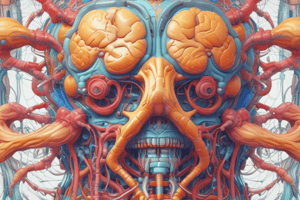Podcast
Questions and Answers
What is the primary purpose of homeostatic mechanisms in living organisms?
What is the primary purpose of homeostatic mechanisms in living organisms?
- To adapt to changing external conditions
- To promote growth and development
- To maintain stability in the internal environment (correct)
- To maintain a constant external environment
What is the typical core body temperature that homeostatic mechanisms aim to maintain in vertebrates?
What is the typical core body temperature that homeostatic mechanisms aim to maintain in vertebrates?
- 40°C (104°F)
- 35°C (95°F)
- 32°C (89.6°F)
- 37°C (98.6°F) (correct)
Which of the following is NOT a physiological response triggered by the hypothalamus when the body's core temperature falls below the set point?
Which of the following is NOT a physiological response triggered by the hypothalamus when the body's core temperature falls below the set point?
- Shivering for warmth
- Increased vasoconstriction
- Increased metabolic rate
- Decreased sweating (correct)
What is the primary mechanism used to maintain homeostasis in living organisms?
What is the primary mechanism used to maintain homeostasis in living organisms?
Which of the following is an example of positive feedback in maintaining homeostasis?
Which of the following is an example of positive feedback in maintaining homeostasis?
How does the pancreas contribute to the regulation of blood glucose levels through negative feedback?
How does the pancreas contribute to the regulation of blood glucose levels through negative feedback?
What is the primary role of insulin in blood sugar regulation?
What is the primary role of insulin in blood sugar regulation?
Which of the following is an example of a positive feedback loop in physiology?
Which of the following is an example of a positive feedback loop in physiology?
How do the kidneys contribute to osmoregulation and maintaining fluid balance?
How do the kidneys contribute to osmoregulation and maintaining fluid balance?
What is the primary function of glucagon in blood sugar regulation?
What is the primary function of glucagon in blood sugar regulation?
Which of the following is a key characteristic of negative feedback loops in physiological systems?
Which of the following is a key characteristic of negative feedback loops in physiological systems?
How does thermoregulation in the body involve negative feedback?
How does thermoregulation in the body involve negative feedback?
Flashcards are hidden until you start studying
Study Notes
Homeostasis refers to the ability of living organisms to maintain stability in their internal environment, despite fluctuations in external factors. It is a fundamental concept in physiology and is essential for survival. Homeostatic mechanisms work across various biological systems to maintain the proper functioning and health of an organism. Although the primary focus of homeostasis is negative feedback, there are instances of positive feedback, which serve distinct roles in maintaining equilibrium.
Thermoregulation
Throughout vertebrates, the body maintains a constant internal temperature around 37°C (98.6°F). This is achieved through a negative feedback loop involving the hypothalamus and heat-sensing thermoreceptors in the skin, muscles, and abdominal viscera. When the body's core temperature falls below the set point, the hypothalamus sends neural impulses that trigger physiological responses, such as shivering for warmth and increased vasoconstriction. Conversely, when the internal temperature rises above the set point, the hypothalamus triggers dissipative responses, like sweating and increased vasodilation to eliminate excess heat.
Negative Feedback
Negative feedback is the primary mechanism used to maintain homeostasis. It functions by reducing excessive responses and limiting variables within their normal range. For example, blood glucose regulation involves negative feedback through the interaction of insulin and glucagon from the pancreas. When blood sugar levels rise, beta cells release insulin, which promotes uptake of glucose into cells and inhibits hepatic gluconeogenesis. Conversely, when blood glucose drops, alpha cells release glucagon, which stimulates glycogen breakdown and thus raises blood glucose levels.
Blood Sugar Regulation
Maintaining stable blood sugar levels (homeostasis) is crucial for physiological processes, especially brain function. The hormones insulin and glucagon are involved in this process. Insulin is released when blood glucose is high, and it promotes glucose uptake by cells, lowering blood glucose levels. Glucagon acts in the opposite way; it is released when blood glucose is low, promoting the breakdown of stored glycogen to raise blood glucose levels.
Osmoregulation
Homeostasis also plays a role in regulating osmotic balance in body fluids. This includes maintaining electrolyte concentrations and overall fluid content. Kidneys play a significant part in regulating osmosis by adjusting urinary composition. If the kidneys detect too little or too much water in the body, they adjust the filtration rate and resorb or excrete water accordingly to restore proper fluid balance.
Positive Feedback
Although primarily associated with destabilization, positive feedback loops can serve important roles in certain biological contexts. One such example is during childbirth. As the baby's head presses on the cervix, neurons send signals to the brain leading to increased oxytocin release, which in turn increases uterine contractions and pressure on the cervix. This self-amplifying loop continues until the baby is born, ensuring efficient expulsion from the mother's body.
In summary, homeostasis is achieved through various complex feedback mechanisms that help maintain stability in critical physiological parameters like temperature, blood sugar, and osmotic balance. While negative feedback is the dominant mode, positive feedback can also have specific roles in essential bodily processes. Understanding these regulatory systems provides insight into how living organisms adapt and respond to internal and external perturbations, ultimately ensuring their survival and wellbeing.
Studying That Suits You
Use AI to generate personalized quizzes and flashcards to suit your learning preferences.




